Transformation tables for administrative borders in Germany
The state has the ability to change the original spatial structure of its administrative regions. The stated goal of such a (municipal) territorial reform is usually an improvement in the performance of individual municipalities regarding planning, administrative and political matters. Since the German reunification in 1990, there have been a number of territorial reforms, especially in the New Federal States (Neue Bundesländer), through which municipalities and districts were merged or split up.
The tables provided here are meant to help users by facilitating work with longitudinal German regional data covering such territorial reforms and hence different territorial states.
A brief overview of the contents and structure of the available tables can be found here.
Access to the files
The IWH provides external researchers with these tables for statistical recalculation of districts and municipalities and the creation of temporally consistent territorial states for non-commercial research purposes only. The data is provided as downloadable Excel files. Access is granted upon application.
Please complete the application form with your personal data and a detailed research proposal, which documents your research interest. Based on this information we will conclude a user contract. Please note our terms of use.
We would like to point out that this free-of-charge offer is intended as assistance for scientists and was created with great care. However, we can not guarantee accuracy, correctness or up-to-dateness of the provided files (further information on the disclaimer of liability can be found in the imprint).
For further questions please contact: fdz@iwh-halle.de.
Publications
Kauffmann, A. (2015a): Wie lässt sich die Bevölkerungsentwicklung von Städten korrekt ermitteln? Eine Methode zur Bereinigung amtlicher Daten um die Effekte von Gebietsänderungen am Beispiel von Ostdeutschland. IWH-Online 5/2015: Leibniz-Institut für Wirtschaftsforschung Halle. LINK
Kauffmann, A. (2015b): Bevölkerungsentwicklung seit 1990 und weitere demographische Indikatoren von 132 ostdeutschen Städten in konstanten Grenzen von 2013. Abbildungsanhang zu IWH-Online 5/2015: Leibniz-Institut für Wirtschaftsforschung Halle. LINK
Kauffmann, A. (2017): Schlüsselbrücken und Matrizen zur statistischen Rückrechnung von Gebietsständen (Gebietsstands-Transformation) für Gemeinden und Kreise Deutschlands. LINK
Your contact

Research Data Centre
If you have any further questions please contact me.
+49 345 7753-758 Request per E-MailPublications
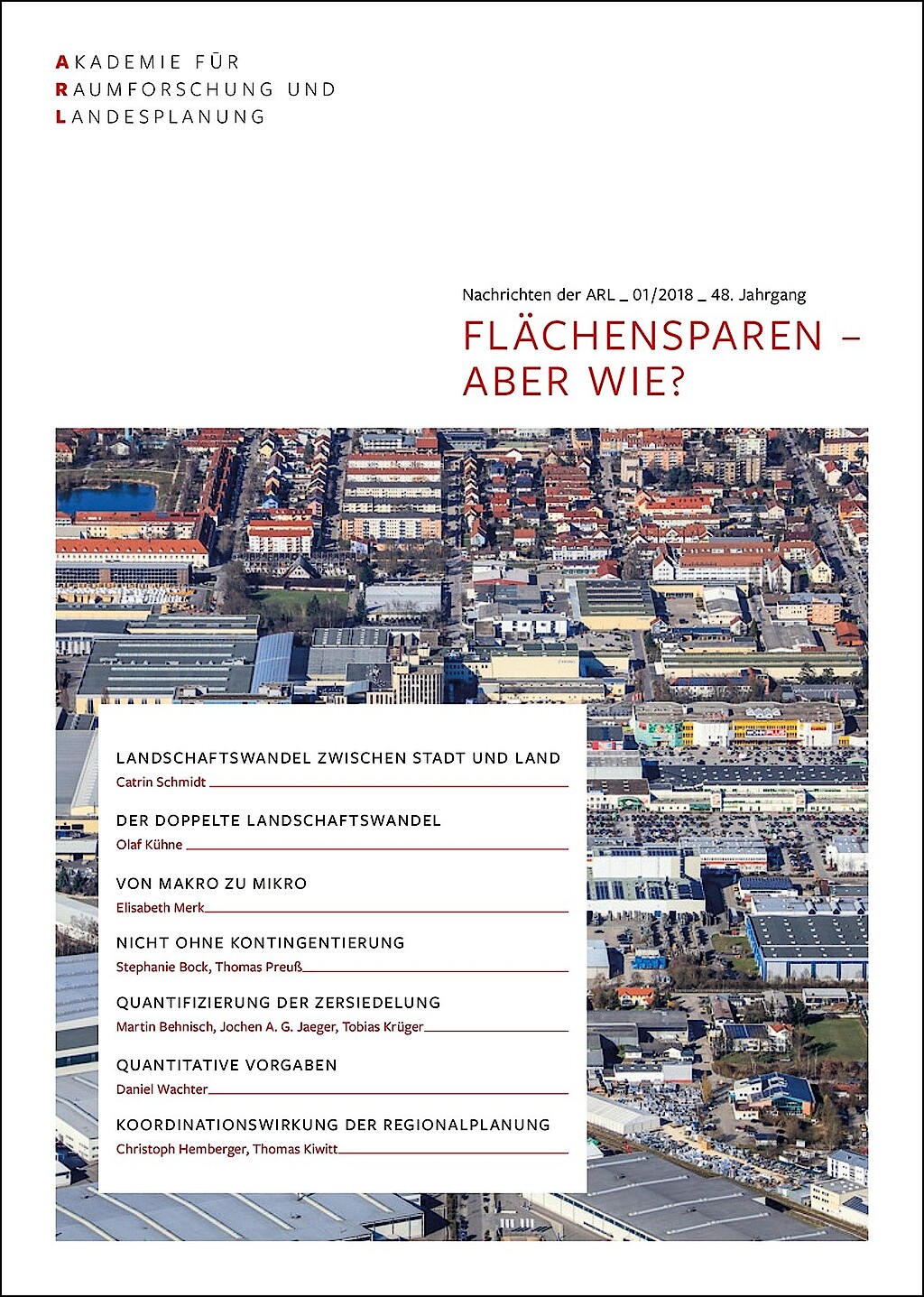
Metropolregionen als Schlüssel zum wirtschaftlichen Erfolg?: 5. „Halle Forum“ des IWH und der ARL am 11./12. Dezember 2014
in: Nachrichten der ARL, No. 2, 2015
Abstract
Seit 2006 findet am Institut für Wirtschaftsforschung Halle (IWH) in Halle an der Saale alle zwei Jahre das „Halle Forum on Urban Economic Growth“ statt. Ziel dieser Veranstaltungsreihe ist es, ein internationales und interdisziplinäres Forum für den Austausch aktueller Forschungsergebnisse zu Strategien und Verläufen der wirtschaftlichen Entwicklung von Städten zu bieten, mit einem Fokus auf altindustrielle Regionen und post-sozialistische Länder. Das nunmehr bereits fünfte „Halle Forum“ befasste sich schwerpunktmäßig mit der „richtigen“ Governance von Metropolregionen und den wirtschaftlichen Effekten von verschiedenen Formen der metropolitanen Governance. Zusätzlich wurden weitere zentrale Zukunftsthemen der Stadtentwicklung aufgegriffen.
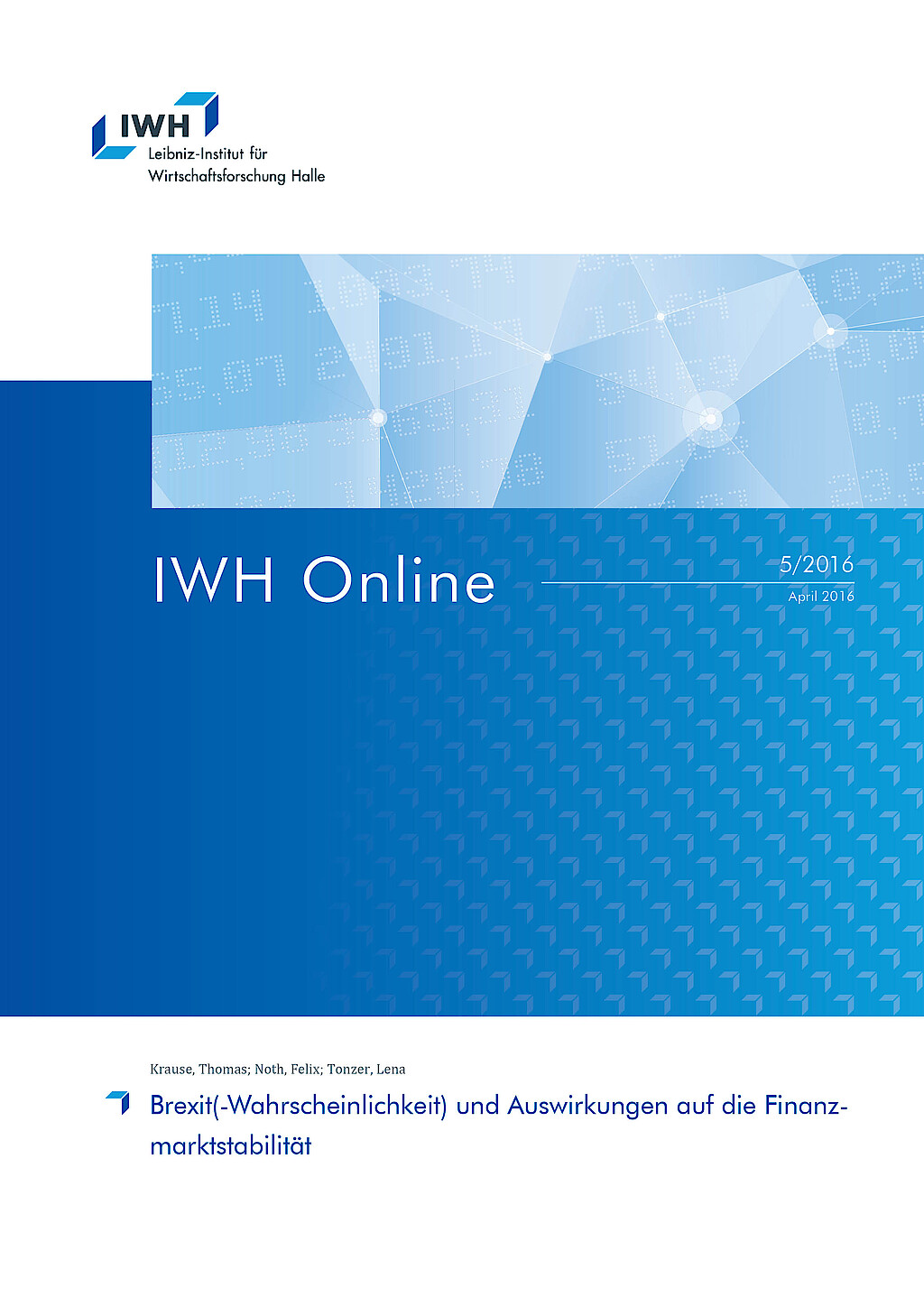
How to Calculate Demographic Indicators of Cities and Municipalities Correctly? A Method to Reassess Official Data for Effects of Municipality Territorial Reforms
in: IWH Online, No. 5, 2015
Abstract
Bevölkerungsstand und -wachstum, Geburten und Sterbefälle, Zu- und Abwanderungen sind wichtige Indikatoren für die Beurteilung der demographischen Entwicklung von Städten und Gemeinden. Diese verlieren jedoch ihre Aussagefähigkeit, wenn z. B. infolge einer Gemeindegebietsreform Bevölkerungsübergänge zwischen Gemeinden stattfinden, die ebenfalls unmittelbare Auswirkungen auf die Bevölkerungsentwickung haben. In Ostdeutschland ist es seit der Vereinigung zu einer Vielzahl von Änderungen von Gemeindegebietszuschnitten gekommen, vor allem infolge von Gemeindegebietsreformen. Währenddessen hat in Ostdeutschland ein demographischer Wandel eingesetzt, dessen Bewältigung die Kenntnis der Entwicklungen auf der Ebene von Städten und Gemeinden auch über längere Zeitabschnitte voraussetzt. Das von der amtlichen Statistik veröffentlichte Gemeindeverzeichnis enthält Daten zur Bevölkerung zum Gebietsstand am Ende einer jeden Periode. Veränderungen des Gebietsstands und daraus resultierende Bevölkerungsübergänge werden in den Listen der Gemeindegebietsänderungen erfasst und publiziert. Im vorliegenden Beitrag wird eine Methode vorgestellt, mit deren Hilfe auf der Ebene von Städten und Gemeinden, aber auch Landkreisen, aus den vorliegenden amtlichen Daten Bevölkerungszahlen früherer Perioden auf die Gebietsstände späterer Perioden umgerechnet werden können. Das Verfahren lässt sich auch auf andere Größen, von denen Proportionalität zur Bevölkerungszahl zu erwarten ist, anwenden.
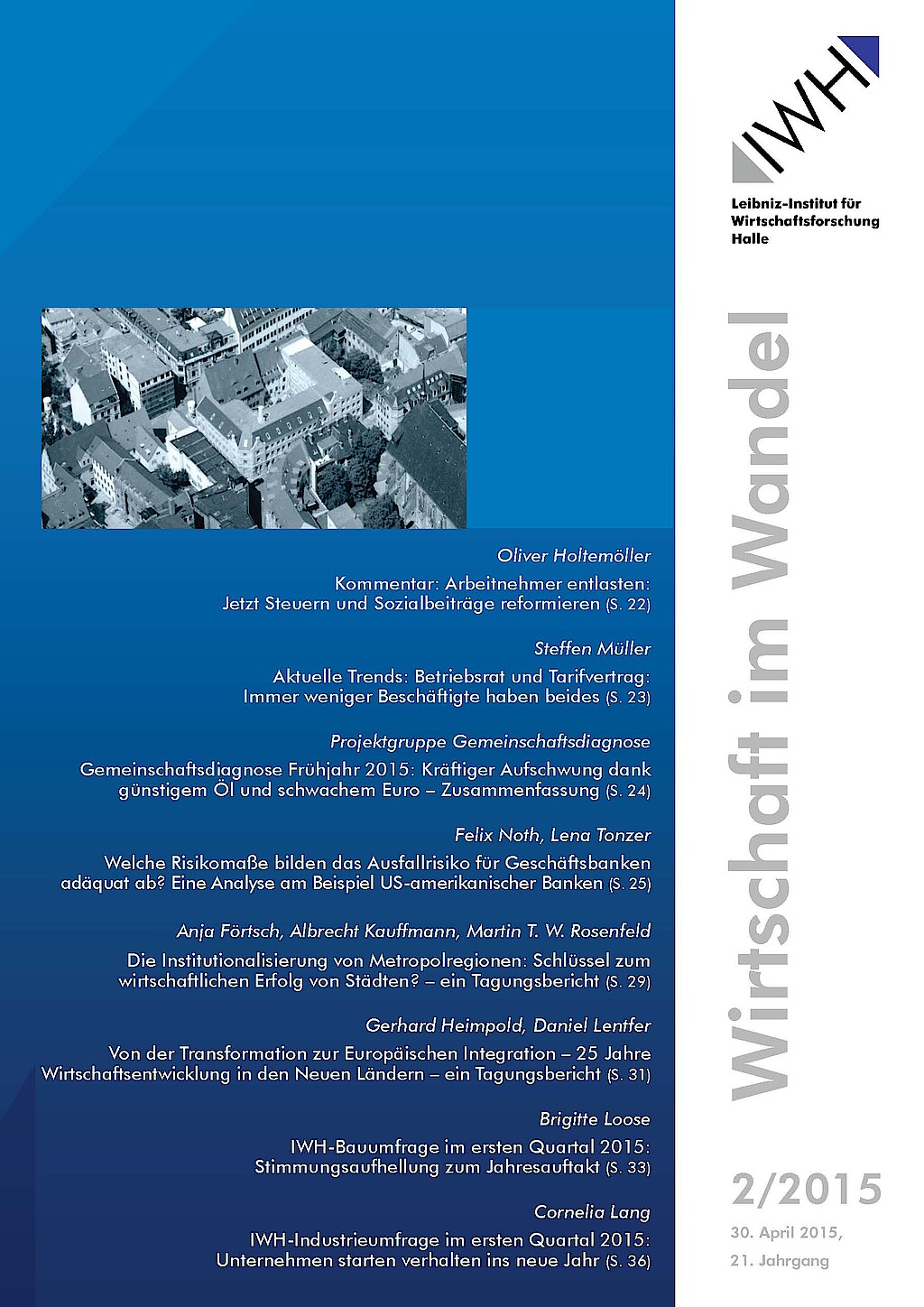
Die Institutionalisierung von Metropolregionen: Schlüssel zum wirtschaftlichen Erfolg von Städten? – Ein Bericht über das „5th Halle Forum on Urban Economic Growth“
in: Wirtschaft im Wandel, No. 2, 2015
Abstract
Seit den 1990er Jahren wird speziell in Deutschland versucht, mit Hilfe einer verstärkten Kooperation zwischen den wichtigsten Oberzentren und den Kommunen aus deren jeweiligem Umland so genannte „Metropolregionen“ zu etablieren. Damit werden die Ziele verfolgt, die internationale Sichtbarkeit der größten deutschen Städte zu verbessern und durch eine Bündelung der in ihnen sowie ihrem Umland vorhandenen Ressourcen und Kompetenzen zu einer Erhöhung der stadtregionalen Wirtschaftsleistung beizutragen. Es stellen sich allerdings die Fragen, ob diese Ziele tatsächlich erreicht werden, welche Hürden sich bei der Zielerreichung ergeben und wie diese Hürden ggf. überwunden werden können. Diese Fragen standen im Mittelpunkt des fünften „Halle Forum on Urban Economic Growth“, das am 11. und 12. Dezember 2014 in Kooperation mit der Akademie für Raumforschung und Landesplanung (ARL) – Leibniz-Forum für Raumwissenschaften am IWH durchgeführt wurde.
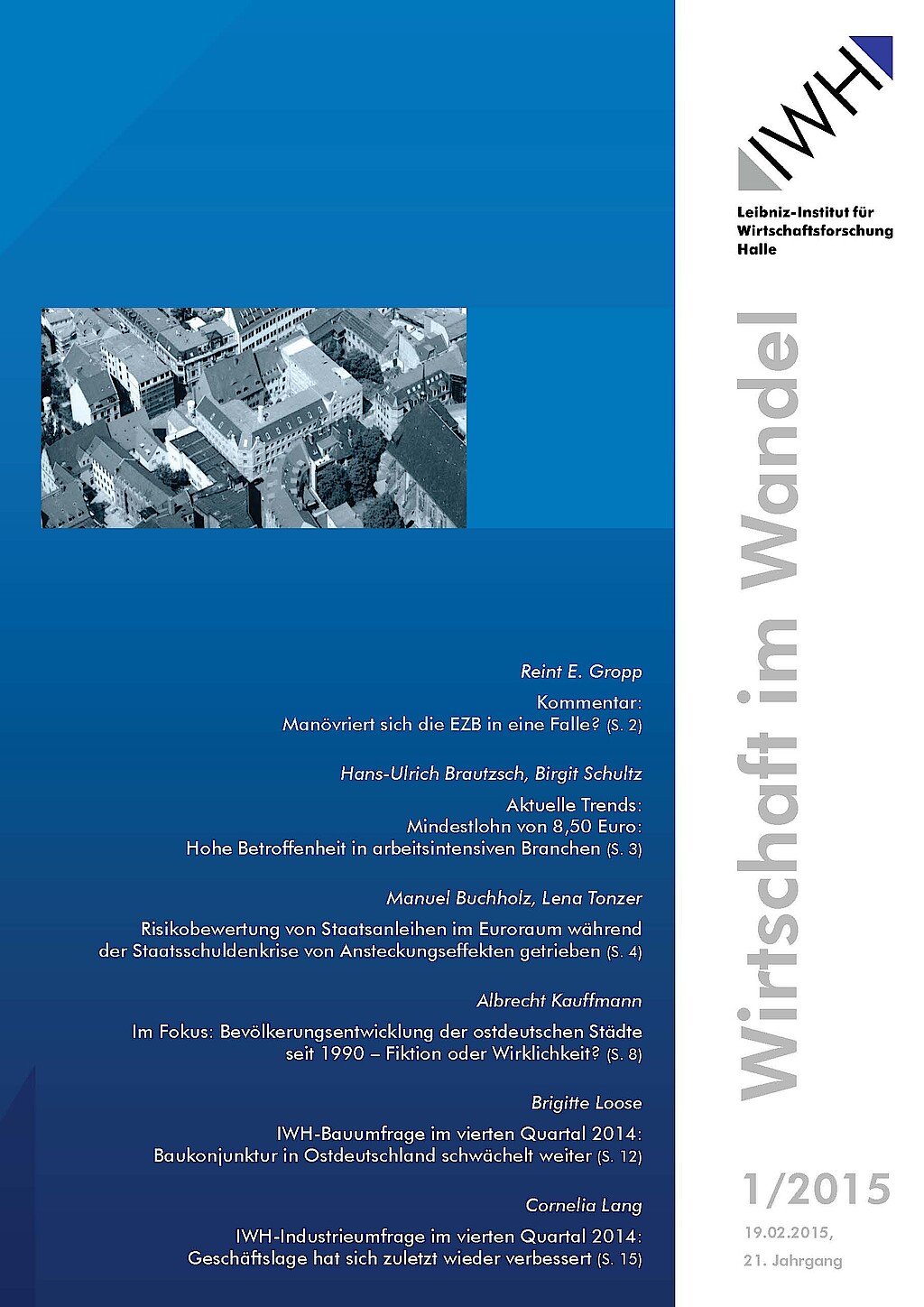
Im Fokus: Bevölkerungsentwicklung der ostdeutschen Städte seit 1990 – Fiktion oder Wirklichkeit?
in: Wirtschaft im Wandel, No. 1, 2015
Abstract
Die Einwohnerzahl und ihre Entwicklung im Zeitverlauf sind zwei der wichtigsten Indikatoren für die Beurteilung der Perspektiven einer Stadt bzw. für die Wahl kommunalpolitischer Strategien. Auch für Investitions- und Standortentscheidungen von Unternehmen sind dies relevante Größen. Der Beitrag zeigt anhand einer Analyse für die 132 größten Städte Ostdeutschlands, dass die von der amtlichen Statistik veröffentlichten Bevölkerungszahlen, die periodisch auf der Grundlage von Fortschreibungen und Volkszählungen zum jeweiligen Gebietsstand ermittelt werden, die demographische Entwicklung der Städte nur bedingt widerspiegeln, da der Einfluss von Gebietsänderungen nicht ohne Weiteres erkennbar ist. Für einen aussagefähigen Städtevergleich ist es unabdingbar, territoriale Veränderungen z. B. infolge von Gemeindegebietsreformen zu berücksichtigen. Dies kann zu einer veränderten Sichtweise beim Vergleich der Entwicklung von Städten führen.

Coordination between Municipalities and Local Non-Municipal Public Units (NMPUs) for Supporting Urban Economic Development: Theoretical Analysis and Empirical Evidence for the Example of Universities in Germany
in: Koordination raumwirksamer Politik: Mehr Effizienz und Wirksamkeit von Politik durch abgestimmte Arbeitsteilung, 2015
Abstract
In zahlreichen europäischen Städten gibt es Versuche, der lokalen Wirtschaftsentwicklung eine neue Richtung zu geben, u.a. durch die Ansiedlung von Nicht-Kommunalen Öffentlichen Einrichtungen (NKOE), z.B. Bundesagenturen, Gerichte, Rechnungshöfe, Landesmuseen oder Universitäten. Allerdings liegen die Kompetenzen für solche NKOE nicht bei den Kommunen, sondern zumeist bei den höheren staatlichen Ebenen. Deshalb haben die Kommunen keinen unmittelbaren Einfluss auf die Ansiedlung von NKOE. Sobald aber eine entsprechende Entscheidung gefallen ist, können die Kommunen die weitere Entwicklung von NKOE begünstigen. Im Beitrag wird zunächst eine Kategorisierung von NKOE durchgeführt, und zwar sowohl gemäß der Bedeutung von NKOE für die lokale Wirtschaftsentwicklung als auch hinsichtlich des Einflusses lokaler Maßnahmen auf die Leistungsfähigkeit von NKOE. Es wird gezeigt, dass Universitäten zu jener Kategorie von NKOE zählen, für die eine Koordination der eigenen Aktivitäten mit jenen der Kommunen besonders wichtig sein dürfte. Die Effekte von Universitäten für die lokale Wirtschaftsentwicklung wurden bereits vielfach diskutiert. Die Fähigkeit der Universitäten, das für ihre Effektivität erforderliche Humankapital zu attrahieren, hängt von verschiedenen lokalen Faktoren ab. Folglich gibt es eine reziproke Beziehung zwischen Kommunen und Universitäten. Eine Koordinierung der jeweiligen Aktivitäten wäre deshalb für beide Seiten von Vorteil. Dies gilt z.B. für den Bereich der Informationspolitik. Eine Kommune sollte nach innen wie nach außen die Vorzüge der örtlichen Universitäten kommunizieren; umgekehrt sollte auch eine Universität die Stärken des lokalen Umfelds deutlich machen. Da für den Bereich der Informationspolitik empirische Daten leicht zugänglich sind, konzentriert sich der empirische Teil des Beitrags auf eine empirische Untersuchung der Internetpräsentationen ausgewählter Städte und Universitäten. Es zeigt sich, dass in den meisten betrachteten Städten die Koordinierung zwischen Kommunen und Universitäten zu wünschen übrig lässt. Eine Verbesserung dieser Situation ließe sich z.B. durch die Einführung finanzieller Anreizmechanismen erreichen.

The Development of Cities and Municipalities in Central and Eastern Europe: Introduction for a Special Issue of 'Urban Research and Practice'
in: Urban Research & Practice, Vol. 7 (3), No. 3, 2014
Abstract
Since the 1990s, local governments in Central and Eastern European (CEE) countries have been confronted by completely new structures and developments. This came after more than 40 years (or even longer in the case of the former Soviet Union) under a socialist regime and behind an iron curtain which isolated them from the non-socialist world. A lack of resources had led to an underinvestment in the refurbishment of older buildings, while relatively cheap ‘prefabricated’ housing had been built, not only in the outskirts of cities, but also within city centres. A lack of resources had also resulted in the fact that the socialist regimes were generally unable to replace old buildings with ‘modern’ ones; hence, there is a very rich heritage of historical monuments in many of these cities today. The centrally planned economies and the development of urban structures (including the shifts of population between cities and regions) were determined by ideology, political rationality and the integration of all CEE countries into the production schemes of the Council for Mutual Economic Assistance and its division of labour by location. The sudden introduction of a market economy, private property, democratic rules, local autonomy for cities and municipalities and access to the global economy and society may be seen as a kind of ‘natural experiment’. How would these new conditions shape the national systems of cities and municipalities? Which cities would shrink and which would grow? How would the relationship between core cities and their surrounding municipalities develop? And what would happen within these cities and with their built environment?
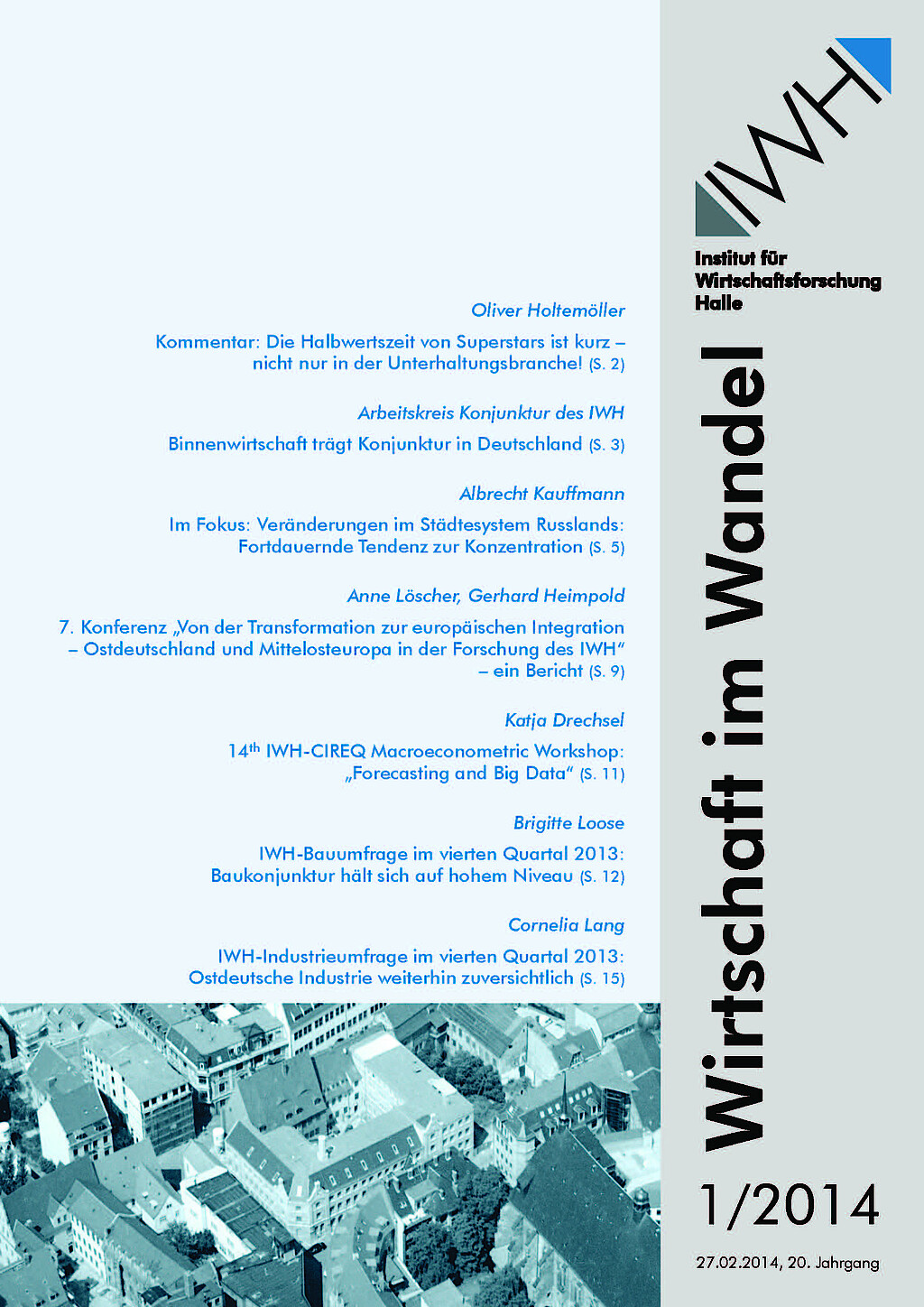
7. Konferenz “Von der Transformation zur europäischen Integration – Ostdeutschland und Mittelosteuropa in der Forschung des IWH“ – ein Bericht
in: Wirtschaft im Wandel, No. 1, 2014
Abstract
Am 16. Dezember 2013 fand am IWH die Konferenz „Von der Transformation zur europäischen Integration – Ostdeutschland und Mittelosteuropa in der Forschung des IWH“ statt. Den Eröffnungsvortrag hielt der Minister für Wissenschaft und Wirtschaft des Landes Sachsen-Anhalt, Hartmut Möllring, zum Thema „Internationalisierungsstrategie für Sachsen-Anhalt: Ziele, Umsetzung und künftige Handlungsbedarfe“. In den darauf folgenden Vorträgen von Wissenschaftlerinnen und Wissenschaftlern des IWH wurden Befunde über die Internationalisierung des FuEStandortes Deutschland, die Umsetzung des europäischen Fiskalpakts und der deutschen Schuldenbremse, die Konjunkturentwicklung in Ostdeutschland und über die Auswirkungen der Preisliberalisierung auf das Städtesystem Russlands präsentiert. Den Abschluss bildete ein Podiumsgespräch mit Persönlichkeiten aus Unternehmen der Region und der Wissenschaft zum Thema: „Ostdeutsche Mittelständler auf Erfolgskurs in Europa – Was steckt dahinter?“

Im Fokus: Veränderungen im Städtesystem Russlands: Fortdauernde Tendenz zur Konzentration
in: Wirtschaft im Wandel, No. 1, 2014
Abstract
Nach dem Ende der kommunistischen Herrschaft in Russland haben der darauf folgende Transformationsschock und die durch ihn in Gang gesetzten Marktprozesse Veränderungen im Städtesystem bewirkt. Anhand eigens aufbereiteter Daten der amtlichen russischen Städtestatistik geht der Beitrag diesen Veränderungen nach. Wichtigste Erkenntnisse sind die Erhöhung der Konzentration der urbanen Bevölkerung und die Verstärkung der Gegensätze zwischen urbanen Kernen und peripheren Räumen. Für die Zeit etwa ab dem Jahr 2000 darf vermutet werden, dass marktwirtschaftliche Prozesse die Veränderungen im Städtesystem beeinflussen. Hierzu kann die Neue Ökonomische Geographie einen wesentlichen Erklärungsbeitrag leisten, insbesondere vor dem Hintergrund des im Zuge der Preisliberalisierung erfolgten, noch nachwirkenden realen Anstiegs der Kosten des Frachtverkehrs. Diese schützen zum einen die im Zentrum ansässigen Unternehmen vor Wettbewerbern außerhalb der Zentren und verteuern zum anderen die Versorgung der peripheren Regionen. Die Untersuchungsergebnisse stützen die Hypothese, dass steigende Transportkosten die Raumstruktur beeinflussen. Vor dem Hintergrund eines möglichen Energiepreisanstiegs besitzen die Beobachtungen am Städtesystem Russlands daher auch für Deutschland Relevanz.
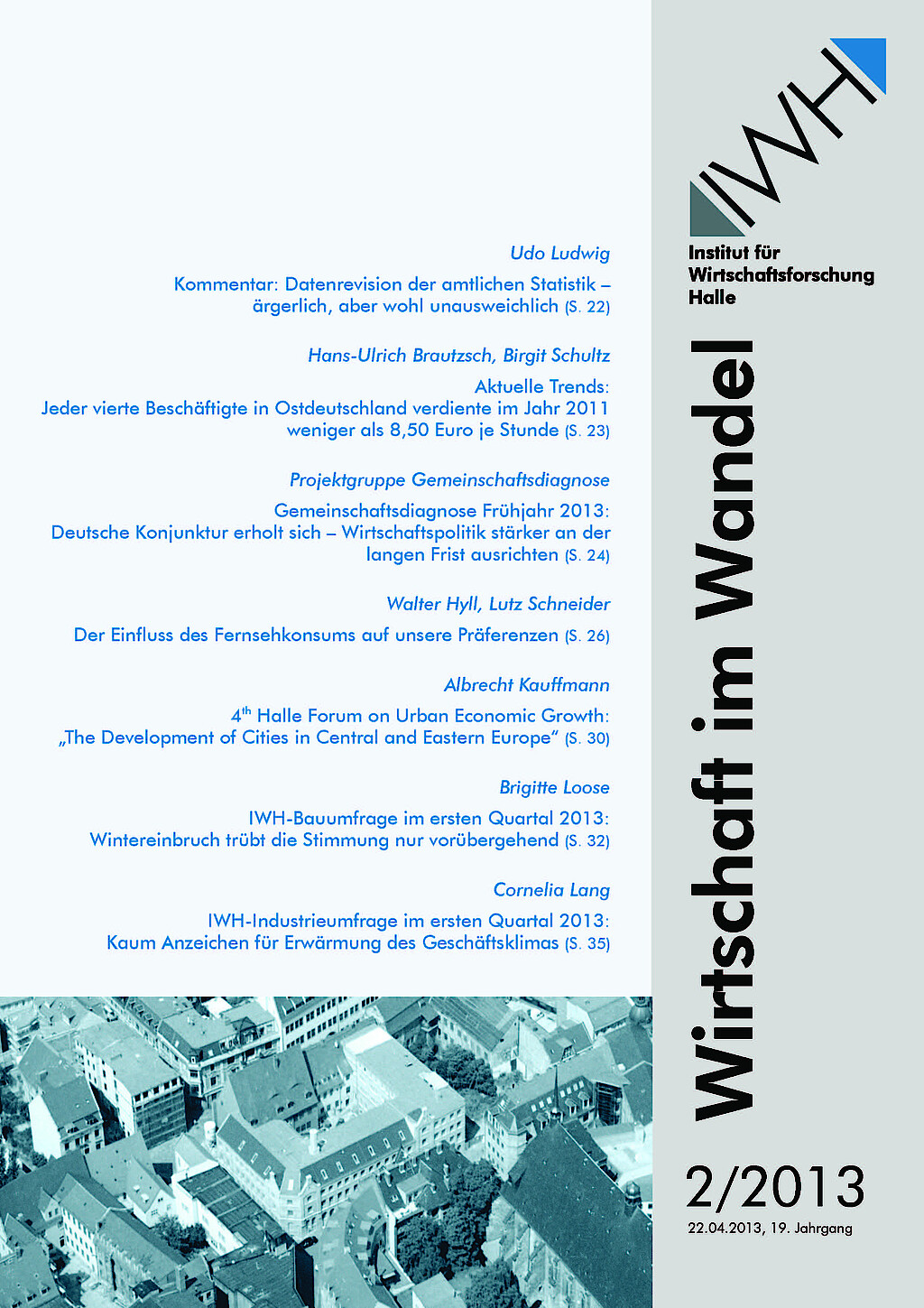
4th Halle Forum on Urban Economic Growth: „The Development of Cities in Central and Eastern Europe“
in: Wirtschaft im Wandel, No. 2, 2013
Abstract
Das Halle Forum on Urban Economic Growth findet seit 2006 im zweijährigen Rhythmus am IWH statt. Die Tagung vom 29. und 30. November 2012 befasste sich mit Problemen der Entwicklung mittel- und osteuropäischer Städte. Thematisch umfassten die Vorträge ein breites Spektrum, in dessen Mitte die Frage nach der Wirkung formeller und informeller Institutionen auf die Stadtentwicklung stand. Sie verstand sich damit gleichzeitig als Auftaktveranstaltung des multinational angelegten IWH-Projekts „The Economic Re-positioning of Post-socialist Cities (RePoCit) – Institutional Settings, Local Strategies and Urban Economic Growth“.

Re-Municipalizing instead of Privatization: The Right Answer to Changing Conditions?
in: Wirtschaftsdienst, No. 2, 2013
Abstract
Mit verschiedenen Faktoren, die sich im Zeitverlauf geändert haben, und ihrem Zusammenspiel mit gegebenen Restriktionen der kommunalen Aufgabenerfüllung (speziell der Krise des kommunalen Einnahmensystems) lässt sich zwar erklären, weshalb zahlreiche Kommunen in Deutschland derzeit darüber nachdenken, bestimmte Leistungen wieder zu rekommunalisieren, die einige Jahre zuvor privatisiert worden waren (bzw. weshalb sie bereits entsprechende Rekommunalisierungen durchgeführt haben). Eine genauere Betrachtung der veränderten Faktoren macht jedoch deutlich, dass die Kommunen auf sie nicht notwendigerweise mit einer Rekommunalisierung antworten müssten – es gäbe auch andere – und vielfach günstigere – Formen der Reaktion.



